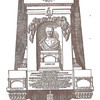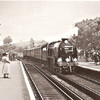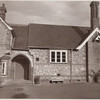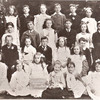The 19th century
The 19th Century saw the erasure of the surviving traces of the Middle Ages and the dawn of our modern world. The last vestiges of feudal customs ceased to exist, the isolation of a rural upland village melted away, and politically the tentacles of the nation state made themselves increasingly felt.
Chipstead continued to be an isolated rural parish until the 1870’s after which the enormous wealth generated in the City and Empire began to attract businessmen looking for a rural residence with convenient access to London. Accordingly, a number of imposing mansions with large estates such as Elmore, Starrock Court and Longshaw were built for the wealthy, and several existing farms were transformed into large country houses and estates.
The census of 1851 showed that the population of the parish had risen to 505, and by 1891 to 688, the land now being dominated by large estates with an increasing demand for domestic staff to support large houses with elaborate gardens, livery stables, dog kennels, and all the other accruements of wealth.
Jolliffe and Banks
The historic Quarry Dean limestone quarries at Merstham play an significant part in the history of Chipstead. Over centuries, these quarries were a nationally important source of building stone and were a source of great wealth to the families who owned them. Two such families, the Tattershalls and the Jolliffes, became Lords of the Manor of Chipstead, although neither family took the title.
The quarry estate was owned by the Tattersall family of Upper Gatton in the 18th century. The Rev’d John Tattersall became Rector of St Margaret’s Church in 1718. In 1788 James Tattersall sold the estate to William Jolliffe of Petersfield, and the Jolliffe dynasty at Merstham House was established.
In 1802 William’s son Hylton inherited the quarry estate came into contact with Edward Banks, who was involved in the construction of the Surrey Iron Railway between Wandsworth and Merstham. This horse drawn railway was the world’s first to have iron rails, and passed through Chipstead, roughly following the alignment of the Brighton Road. Jolliffe saw the railway as a means to transport his quarry stone to the Thames for onward conveyance by water, and entered into partnership with Banks to create the firm of Jolliffe and Banks. In 1803, Hylton Jolliffe handed the business over to his younger brother, the Rev. William Jolliffe.
The Jolliffe and Banks company rapidly expanded and became one of the principal construction companies of the time, with a portfolio of prestigious contracts in London including Waterloo Bridge (1817), Southwark Bridge (1819), and finally the New London Bridge opened by King William in 1824. Banks was knighted in 1822. The partnership of these two remarkable men was dissolved in 1834 but neither lived long enough to enjoy their hard-earned fortunes as both died in 1835. Banks is buried in St Margaret’s churchyard.
The Manor of Chipstead was acquired by the Jolliffe family from the Tattersalls in the 1790s and as the tithe map of 1847 shows, the family owned a substantial area of land. Rev William Jolliffe’s son, Sir William G Hylton Jolliffe (1800–1876) became an MP in 1837. He held the seat at Petersfield until 1866 when he was granted the title 1st Baron Hylton of Merstham, and his descendents as Lord Hylton continued to hold the title until recent times. The areas of land in Chipstead known as the Hylton Estate survive to this day.
The Tattenham Corner Railway
In 1885 Henry Cosmo Orme Bonsor, the son of Joseph Bonsor of Polesden Lacey, purchased the Kingswood Warren estate. He was a City financier, a Director of the Bank of England and became MP for Kingswood Warren. He foresaw that bringing a railway to Kingswood would enhance the value of land which had never been very good for agricultural purposes, and would attract London financiers who wished to live in a healthy rural environment.
Accordingly, in 1896, he turned his attention to railways, became chairman of the South Eastern Railway, and proposed a line from Purley through the Chipstead valley to Kingswood. This idea initially met with some opposition from his fellow directors, since the line followed difficult terrain involving deep cuttings, high bridges, tunnels and tight bends. However, Bonsor won the day and construction began in 1896.
The new railway became fit to operate trains over a single track as far as Kingswood on 2nd November 1897 and regular services began a week later. In 1899 Chipstead station (named Chipstead and Banstead Downs) was opened, equipped with a passing loop, and the following year trains ran to Walton-on-the-Hill (now Tadworth). In November 1900 the track was doubled and on Derby Day 1901 trains ran through to Tattenham Corner. Woodmansterne station was not built until the 1930s.
Kingswood Station was built to an elegant standard, no doubt because it was Bonsor’s personal railhead. In order to attract day trippers to the area and, perhaps, potential house-buyers, an open air terrace was provided on top of the platform canopy for afternoon tea. However, by 1920 soot and steam from the locomotives discharged immediately beneath the customers’ noses had rendered that enterprise unprofitable!
Electric trains appeared on the line in March 1928 and were operating the complete service by June of that year. However, steam engines continued to be used for freight and shunting duties until the freight sidings at Chipstead and other stations on the line were finally closed in 1962.
The most notable event on the line was the passage of the Royal Train to Tattenham Corner on Derby Day each year, hauled by a steam locomotive until 1963. The Royal Train was discontinued in 1998 to save costs to the Royal Purse!
November 9th 1997 marked the centenary of the opening of the line for passenger services. A special train bearing the name of Sir Cosmo Bonsor was created which operates on the Tattenham Corner line today.
In the 1980s the railway implemented a policy of replacing old railway station buildings on branch lines with shelters and ticket cabins. Consequently, the Chipstead station building became very dilapidated and was no longer used by railway passengers. It was sold to a developer in 1998 and divided vertically to create three town houses.
Chipstead Primary School
Chipstead Primary School opened in 1874 and was run by the Mary Stephens Foundation as a non-fee paying school for the children of the village between 4 and 14. It was taken over by the Surrey County Council in 1902 as a state school. Pupils used to take the 11+ examination to the grammar schools in Reigate and Purley, the unsuccessful candidates going to Chipstead Valley Secondary Modern (now a primary school).
Despite considerable protest from parents in the village, the school finally closed in 1994 and most children were transferred to Woodmansterne County Primary School. The school was sold to a developer and sympathetically divided into individual dwellings as the School Mews development. The headmaster used to live on site in the house which is now called Headmaster's Cottage.













